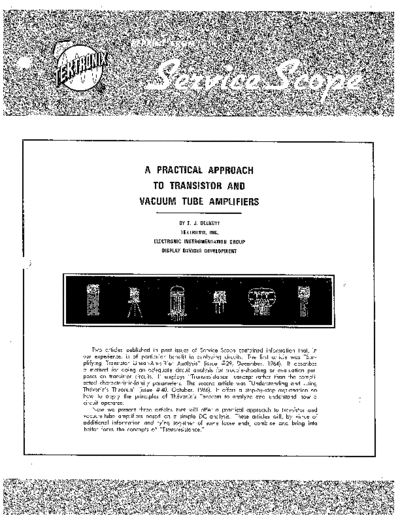Service Manuals, User Guides, Schematic Diagrams or docs for : Tektronix publikacje Pract_Trns_VT_Amps
<< Back | HomeMost service manuals and schematics are PDF files, so You will need Adobre Acrobat Reader to view : Acrobat Download Some of the files are DjVu format. Readers and resources available here : DjVu Resources
For the compressed files, most common are zip and rar. Please, extract files with Your favorite compression software ( WinZip, WinRAR ... ) before viewing. If a document has multiple parts, You should download all, before extracting.
Good luck. Repair on Your own risk. Make sure You know what You are doing.
Image preview - the first page of the document

>> Download Pract_Trns_VT_Amps documenatation <<
Text preview - extract from the document
A PRACTICAL APPROACH
TO TRANSIST
VACUUM TUBE AMPLIFIERS
BY F. J. BECKETT
TEKTRONIX, INC.
ELECTRONIC INSTRUMENTATION GROUP
DISPLAY DEVICES DEVELOPMENT
Two articles published in past issues of Service Scope contained information that, in
our experience, i s of particular benefit in analyzing circuits. The first article was "Sim-
plifying Transistor Linear-Amplifier Analysis" (issue #29, December, 1964). It describes
a method for doing an adequate circuit analysis for trouble-shooting or evaluation pur-
poses on transistor circuits. It employs "Transresistance" concept rather than the compli-
cated characteristic-family parameters. The second article was "Understanding and Using
Th6venin's Theorem" (issue #40, October, 1966). It offers a step-by-step explanation on
how to apply the principles of ThBvenin's Theorem to analyze and understand how a
circuit operates.
Now we present three articles that will offer a practical approach to transistor and
vacuum-tube amplifiers based on a simple DC analysis. These articles will, by virtue of
additional information and tying together of some loose ends, combine and bring into
better focus the concepts of "Transresistance."
Part I
THE TRANSISTOR AMPLIFIER
INTRODUCTION
Tubes and transistors are often used to- there is an analogy between the two. I t 50, it seems pointless not to pursue this ap-
gether to achieve a particular result. Vacu- is true of course, that the two are entire- proach to its logical conclusion.
um tubes still serve an important role in ly different in concept; but, so often we I n this first article we will look a t a
electronics and will do so for many years come across a situation where one can be transistor amplifier as a simple D C model ;
t o come despite a determined move towards explained in terms of the other that it is and then, in the second article, look a t a
solid state circuits. very desirable to recognize this fact vacuum-tube amplifier in a similar light.
W e will assume that both devices are op-
Whether a circuit is designed around Transistor and vacuum tube data give us erated as linear amplifiers and then use
vacuum tubes o r transistors or both, it is very little help in the practical sense. P a - the results in a practical way.
important to recognize the fact that the rameter Curves and electrical data show One must bear in mind that this ap-
t w o are in many ways complementary. I t the behavior of these devices under very proach cannot be assumed in all cases.
is wrong to divorce vacuum tubes and defined conditions. I n short, they are more I t is, as it is meant to be, a simple analy-
transistors as separate identities each pe- useful to the designer than the technician. sis but the results will prove to be a valu-
culiar to their own mode of operation. \Ye are often reduced to explaining most able tool in trouble-shooting and under-
Indeed, as this series of articles will s h o ~ circuits in terms of an ohms law approach; standing circuits.
L e t us consider the general equation f o ~ One is quite justified in looking at a
current through a P.N. diode junction. OR J E C T I V E transistor in terms of the two-diode con-
v The objective of this paper is to present
cept, refer to Figure 3. Therefore, assum-
(1) ing diode A to be forward biased and di-
a practical approach to Transistor and
ode B to be reverse biased, as would be the
where V = applied volts Vacuum-tube amplifiers based on a simple
case if we were to operate the transistor
D C analysis.
I, = reverse bias current as a linear amplifier, the current through
= constant between 1 & 2 The articles will be published in the fol- diode A will conform to equation ( 1 ) .
kT lowing sequence. Let us take a closer look at Figure 2.
and V, = - where k = Boltzmans
W e define conductance in the gener*,
cl 1. The Transistor Amplifier.
Const., 1.38 s l O ~ ' ~ o u l e / " K e l v i n 2. The Vacuum-tube Amplifier. case as
T = absolute temperature in degree Kel- 3. An analysis of a typical Tektronix hy- I
g=-
vin at room temperature, i.e., T = 300◦ Jabse Service Manual Search 2024 ◦ Jabse Pravopis ◦ onTap.bg ◦ Other service manual resources online : Fixya ◦ eServiceinfo